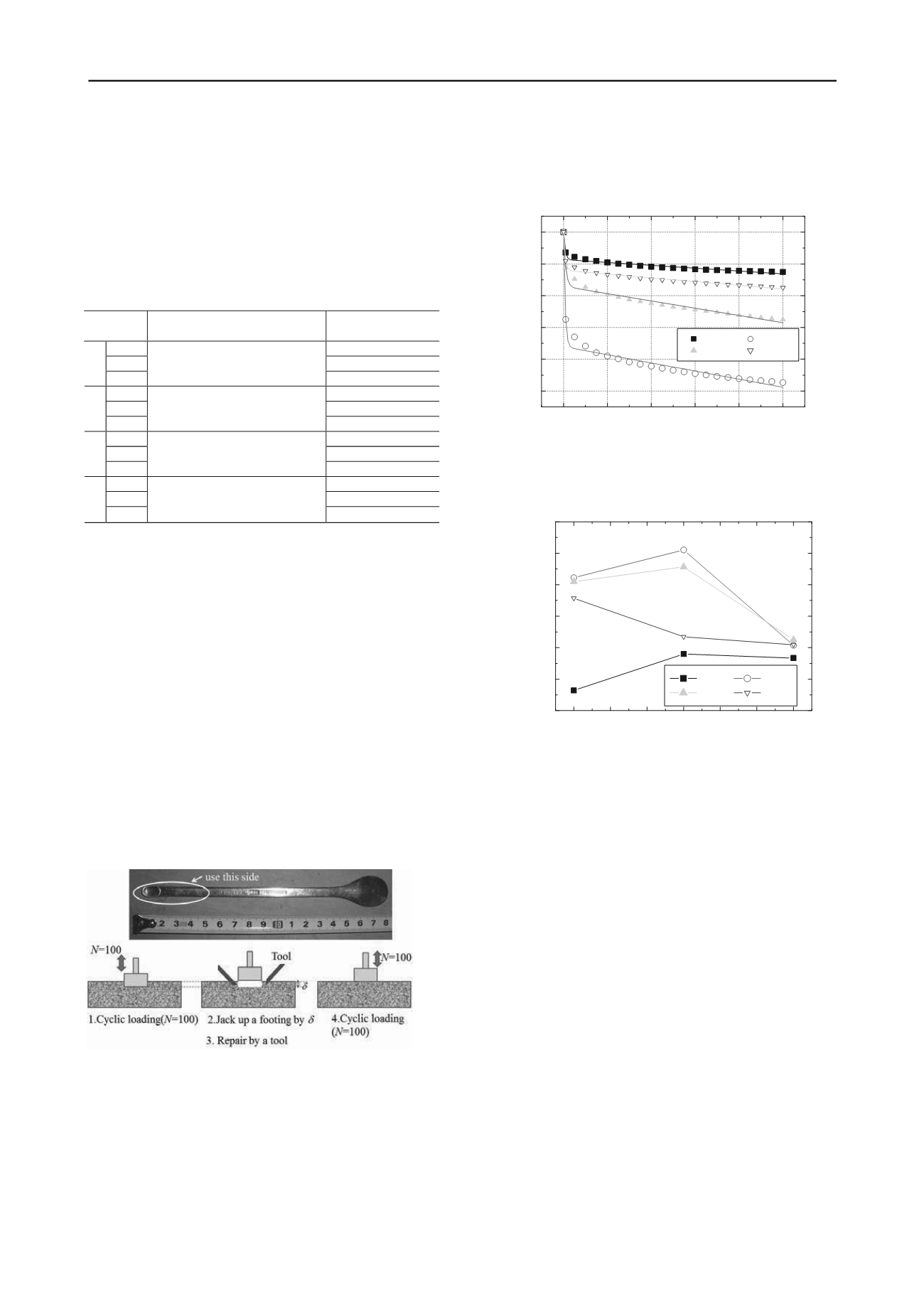
1276
Proceedings of the 18
th
International Conference on Soil Mechanics and Geotechnical Engineering, Paris 2013
H
of 60 mm, mean diameter
D
50
of 0.21 mm, and uniform
coefficient
U
c
of 1.70
.
Reinforced roadbeds were introduced in Cases 3 and 4. A
Toyoura sand roadbed (
D
r
= 90%,
H
= 60 mm) was overlain by
an asphalt mixture layer in Case 3, and a Natom sand roadbed
(
D
r
= 95%,
H
= 60 mm) was overlain by the same asphalt
mixture layer in Case 4. The
D
50
of the Natom sand was 0.70
mm, and its
U
c
was 3.09. The 10 mm thick asphalt mixture was
composed of straight asphalt 80–100 and sands.
Table 1. Model ground conditions
Cyclic loadings were applied to the model grounds with
footing at a constant displacement rate of 0.05 mm/s. The
amplitude of the cyclic stress applied in Case 1 was 110 kN/m
2
;
that applied in Cases 2, 3, and 4 was 80 kN/m
2
. During the
cyclic loadings, consecutive images of the model grounds were
captured by a digital camera.
In each test, 100 cyclic loadings were first applied. Tie-
tamper repair modeling was performed in the following manner.
As shown in Fig. 2, the footing was reset to the initial position
after 100 cyclic loadings were applied. A small spoon was next
inserted into the model ground near lateral sides of the footing.
After the spoon reached a fixed ground depth, it was tilted
several times to permit the crushed stones to move laterally.
This procedure was followed at several locations until the voids
between the footing and the ground surface were completely
filled by the crushed stones. Finally, additional crushed stones
were introduced to the ground surface near the footing sides to
produce a flat ground surface. After this tie-tamper modeling
was implemented, 100 of cyclic loadings were applied again.
Figure 2. Tool and procedure used for simulating tie-tamper repair
3 RESIDUAL DEFORMATION CHARACTERISTICS
3.1 Effects of ballast thickness
The relationships between the number of cyclic loadings
N
and
footing settlement
were obtained before and after tie-tamper
repair, as shown in Fig. 3. Each relationship obtained could be
fitted by the following equation
2)
:
N
e C
N
1
(1)
where
C
and
are parameters representing the initial settlement
process, and
represents the process of gradual subsidence.
0
20
40
60
80
100
10
8
6
4
2
0
Case1-2
Case2-2
Case3-2
Case4-2
H
b
=50mm
Number of cyclic loading ,
N
Settlement of footing
,
(mm)
Figure 3. Relationships between number of cyclic loading cycles and
footing settlement before tie-tamper implementation. Ballast thickness,
H
b
, = 50 mm
Figure 4. Relationships between gradual subsidence parameter
and
ballast thickness
H
b
before tie-tamper implementation
Figure 4 shows the relationships between the gradual
subsidence parameter
and ballast thickness
H
b
before tie-
tamper implementation. It should be noted that 50 mm
H
b
was
used to represent the 250 mm ballast thickness adopted for the
standard design because the model size was at a scale of one-
fifth. Interestingly, it is seen in the figure that
was highest
when
H
b
= 50 mm in Cases 2 and 3. High
values indicate a
substantial amount of gradual settlement; thus, these results
suggest that the standard ballast thickness of 250 mm is
ineffective for minimal settling.
The residual settlement characteristics were investigated in
detail with PIV analysis. First, the displacement magnitude and
direction of crushed stones and roadbeds induced by 100 cyclic
loadings were estimated by analyzing consecutive digital
images. The distributions of maximum shear strain
max
generated in the crushed stones and roadbeds were next
calculated. Figures 5 to 7 show the results obtained from Cases
1, 2, and 3. Results could not be obtained from Case 4 because
the monotonic color of dark gray Natom sand resulted in
ineffective pattern matching of PIV.
As shown in Fig. 5, a high value of
max
was noted in Cases
1-1 and 1-2 until the ground depth reached the bottom steel
plate. However, the concentration of
max
could not be observed
in Case 1-3 near the bottom steel plate. Similarly, the
concentration of
max
could not be observed in the roadbeds for
Cases 2-3 and 3-3, as shown in Figs. 6 and 7. These results
indicate that when
H
b
= 80 mm,
max
can be sustained in
Case No.
Roadbed
Ballast thickness
H
b
(mm)
1-1
20
1-2
50
1
1-3
Steel (Bottom plate of a sand
box)
80
2-1
20
2-2
50
2
2-3
Toyoura sand (
D
r
= 90%,
H
=
60 mm)
80
3-1
20
3-2
50
3
3-3
Toyoura sand (
D
r
= 90%,
H
=
60 mm) + Asphalt mixture
(layer thickness = 10 mm)
80
4-1
20
4-2
50
4
4-3
Natom sand (
D
r
= 95%,
H
= 60
mm) + Asphalt mixture (layer
thickness = 10 mm)
80
20 30 40 50 60 70 80
0.000
0.005
0.010
0.015
0.020
0.025
0.030
Case1
Case2
Case3
Case4
Ballast thickness,
H
b
(mm)


